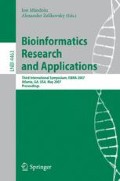Abstract
Here we introduce a new Multi-Stack (MS) based phylogenetic tree building method. The Multi-Stack approach organizes the candidate subtrees (i.e. those having same number of leaves) into limited priority queues, always selecting the K-best subtrees, according to their distance estimation error. Using the K-best subtrees our method iteratively applies a novel subtree joining strategy to generate candidate higher level subtrees from the existing low-level ones. This new MS method uses the Constrained Least Squares Criteria (CLSC) which guarantees the non-negativity of the edge weights.
The method was evaluated on real-life datasets as well as on artificial data. Our empirical study consists of three very different biological domains, and the artificial tests were carried out by applying a proper model population generator which evolves the sequences according to the predetermined branching pattern of a randomly generated model tree. The MS method was compared with the Unweighted Pair Group Method (UPGMA), Neighbor-Joining (NJ), Maximum Likelihood (ML) and Fitch-Margoliash (FM) methods in terms of Branch Score Distance (BSD) and Distance Estimation Error (DEE). The results show clearly that the MS method can achieve improvements in building phylogenetic trees.
Access this chapter
Tax calculation will be finalised at checkout
Purchases are for personal use only
Preview
Unable to display preview. Download preview PDF.
References
Rohlf, F.J.: Classification of Aedes by numerical taxonomic methods (Diptera: Culicidae). Ann. Entomol. Soc. Am. 56, 798–804 (1963)
Saitou, N., Nei, M.: The neighbor-joining method: a new method for reconstructing phylogenetic trees. Mol. Biol. Evol. 4(4), 406–425 (1987)
Atteson, K.: The performance of neighbor-joining methods of phylogenetic reconstruction. Algorithmica 25 (1999)
Fitch, W.M., Margoliash, E.: Construction of phylogenetic trees. Science 155, 279–284 (1967)
Bryant, D., Waddell, P.: Rapid Evaluation of Least-Squares and Minimum-Evolution Criteria on Phylogenetic Trees. Mol. Biol. Evol. 15(10), 1346–1359 (1998)
Cavalli-Sforza, L., Edwards, A.: Phylogenetic analysis models and estimation procedures. Evolution 32, 550–570 (1967)
Levenberg-Marquardt nonlinear least squares algorithms in C/C++, http://www.ics.forth.gr/~lourakis/levmar/
Day, W.H.E.: Computational complexity of inferring phylogenies from dissimilarity matrices. Bulletin of Mathematical Biology 49, 461–467 (1986)
Goloboff, P.A.: Analysing large data sets in reasonable times: Solutions for composite optima. Cladistics 15, 415–428 (1999)
Bahl, L.R., Gopalakrishnan, P.S., Mercer, R.L.: Search Issues in Large Vocabulary Speech Recognition. In: Proceedings of the 1993 IEEE Workshop on Automatic Speech Recognition, Snowbird, UT (1993)
Robinson, D.F., Foulds, L.R.: Comparison of phylogenetic trees. Math. Biosci. 53, 131–147 (1981)
Kuhner, M.K., Felsenstein, J.: A simulation comparison of phylogeny algorithms under equal and unequal evolutionary rates. Mol. Biol. Evol. 12(3), 525 (1995)
Gosztolya, G., Kocsor, A.: Improving the Multi-stack Decoding Algorithm in a Segment-Based Speech Recognizer. In: Chung, P.W.H., Hinde, C.J., Ali, M. (eds.) IEA/AIE 2003. LNCS, vol. 2718, pp. 744–749. Springer, Heidelberg (2003)
Needleman, S.B., Wunsch, C.D.: A general method applicable to the search for similarities in the amino acid sequence of two proteins. J. Mol. Biol. 48, 443–453 (1970)
Henikoff, S., Henikoff, J.: Amino acid substitution matrices from protein blocks. Proc. Natl. Acad. Sci. USA 89(22), 10915–10919 (1992)
Jukes, T.H., Cantor, C.R.: Evolution of protein molecules. In: Munro, H.N. (ed.) Mammalian Protein Metabolism, pp. 21–132. Academic Press, New York (1969)
Zuckerland, E., Pauling, L.: Molecular disease, evolution, and genetic heterogeneity. In: Kasha, M., Pullman, B. (eds.) Horizons in Biochemistry, pp. 189–225. Academic Press, New York (1965)
Dickerson, R.E.: The structures of cytochrome c and the rates of molecular evolution. J. Mol. Evol. 1, 26–45 (1971)
Cilibrasi, R., Vitányi, P.: Clustering by compression. IEEE Transactions on Infomation Theory (2004)
Ziv, J., Lempel, A.: A universal algorithm for sequential data compression. IEEE Trans. on Inf. Th. 23, 337–343 (1977)
Nevill-Manning, C.G., Witten, I.H.: Compression and explanation using hierarchical grammars. Computer Journal 40(2-3), 103–116 (1997)
Ovchinnikov, I., et al.: Molecular analysis of Neanderthal DNA from the northern Caucasus. Nature 404(6777), 490–493 (2000)
Vignais, P.M., Billoud, B., Meyer, J.: Classification and phylogeny of hydrogenases. FEMS Microbiology Reviews 25, 455–501 (2001)
Felsenstein, J.: Evolutionary trees from DNA sequences: a maximum likelihood approach. J. Mol. Evol. 17, 368–376 (1981)
Phylip program package, http://evolution.genetics.washington.edu
Author information
Authors and Affiliations
Editor information
Rights and permissions
Copyright information
© 2007 Springer-Verlag Berlin Heidelberg
About this paper
Cite this paper
Busa-Fekete, R., Kocsor, A., Bagyinka, C. (2007). A Multi-Stack Based Phylogenetic Tree Building Method. In: Măndoiu, I., Zelikovsky, A. (eds) Bioinformatics Research and Applications. ISBRA 2007. Lecture Notes in Computer Science(), vol 4463. Springer, Berlin, Heidelberg. https://doi.org/10.1007/978-3-540-72031-7_5
Download citation
DOI: https://doi.org/10.1007/978-3-540-72031-7_5
Publisher Name: Springer, Berlin, Heidelberg
Print ISBN: 978-3-540-72030-0
Online ISBN: 978-3-540-72031-7
eBook Packages: Computer ScienceComputer Science (R0)

